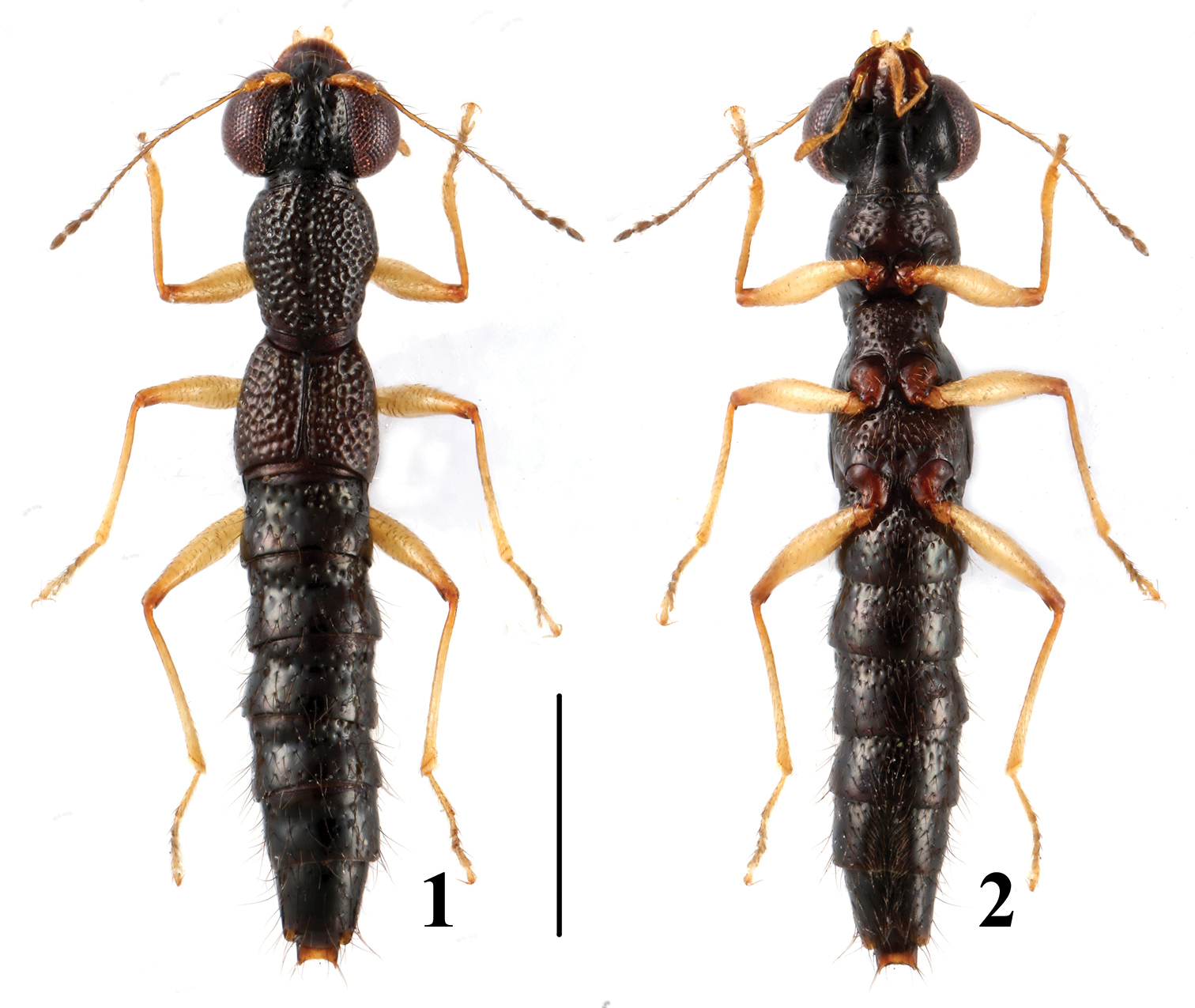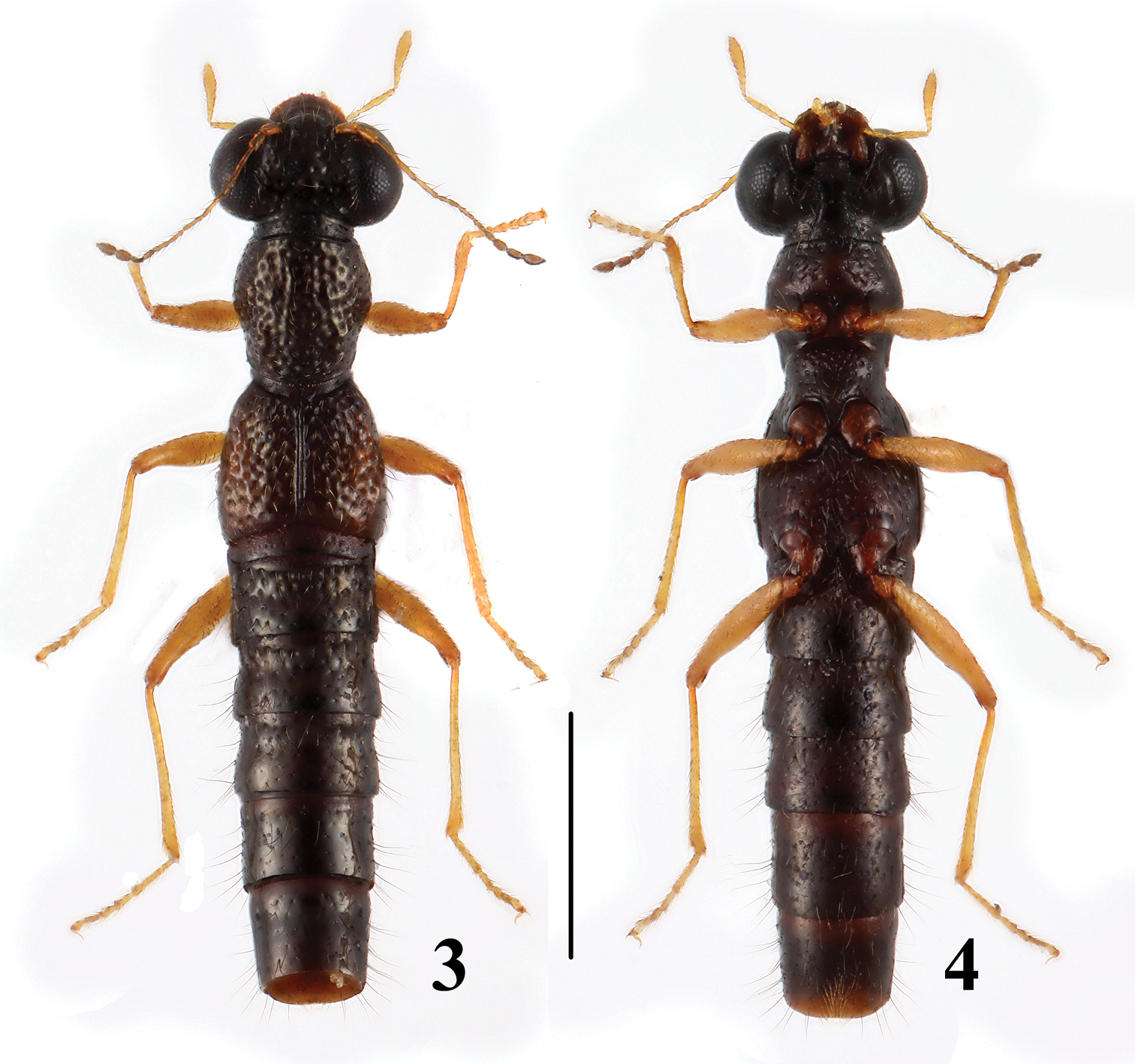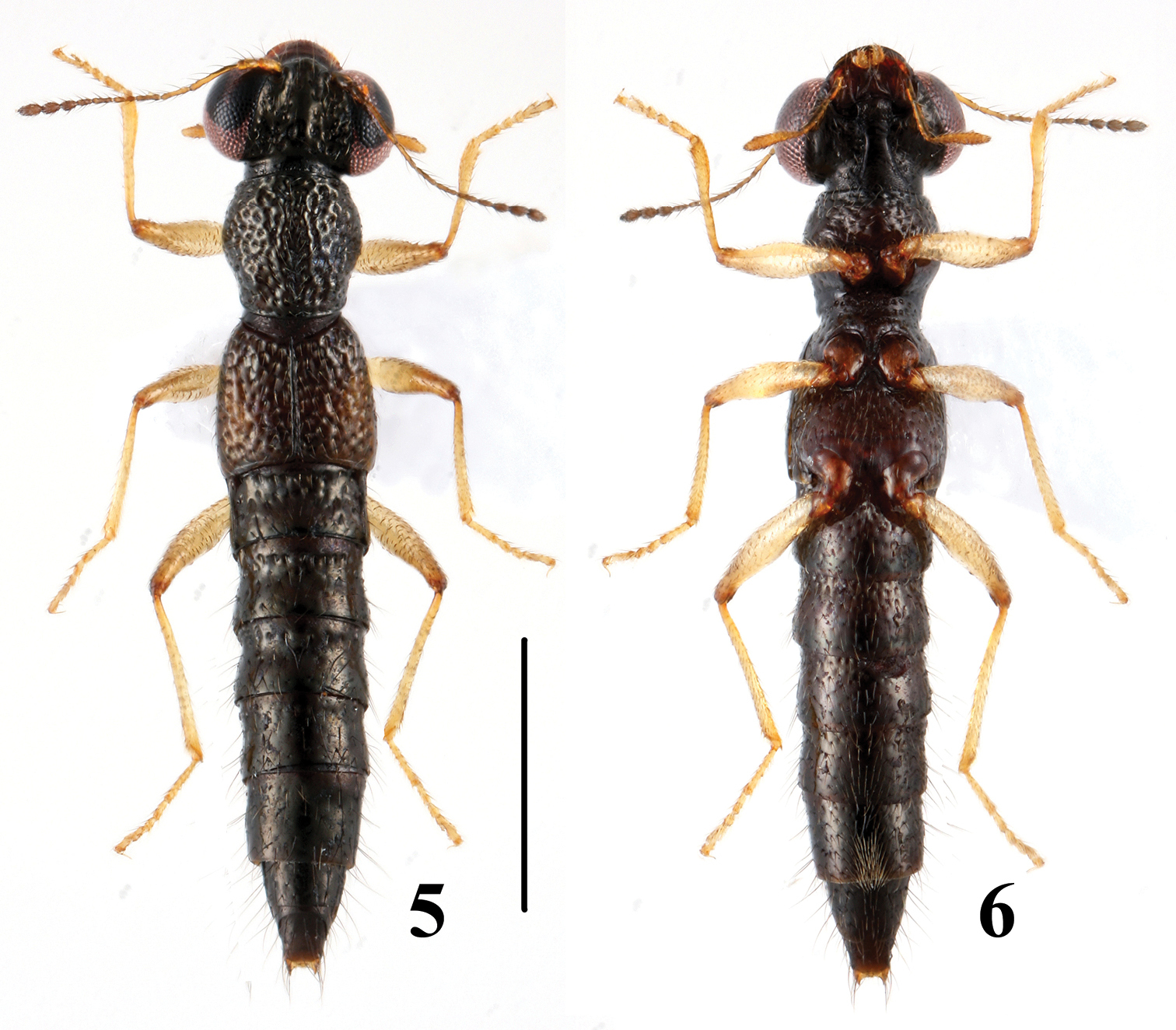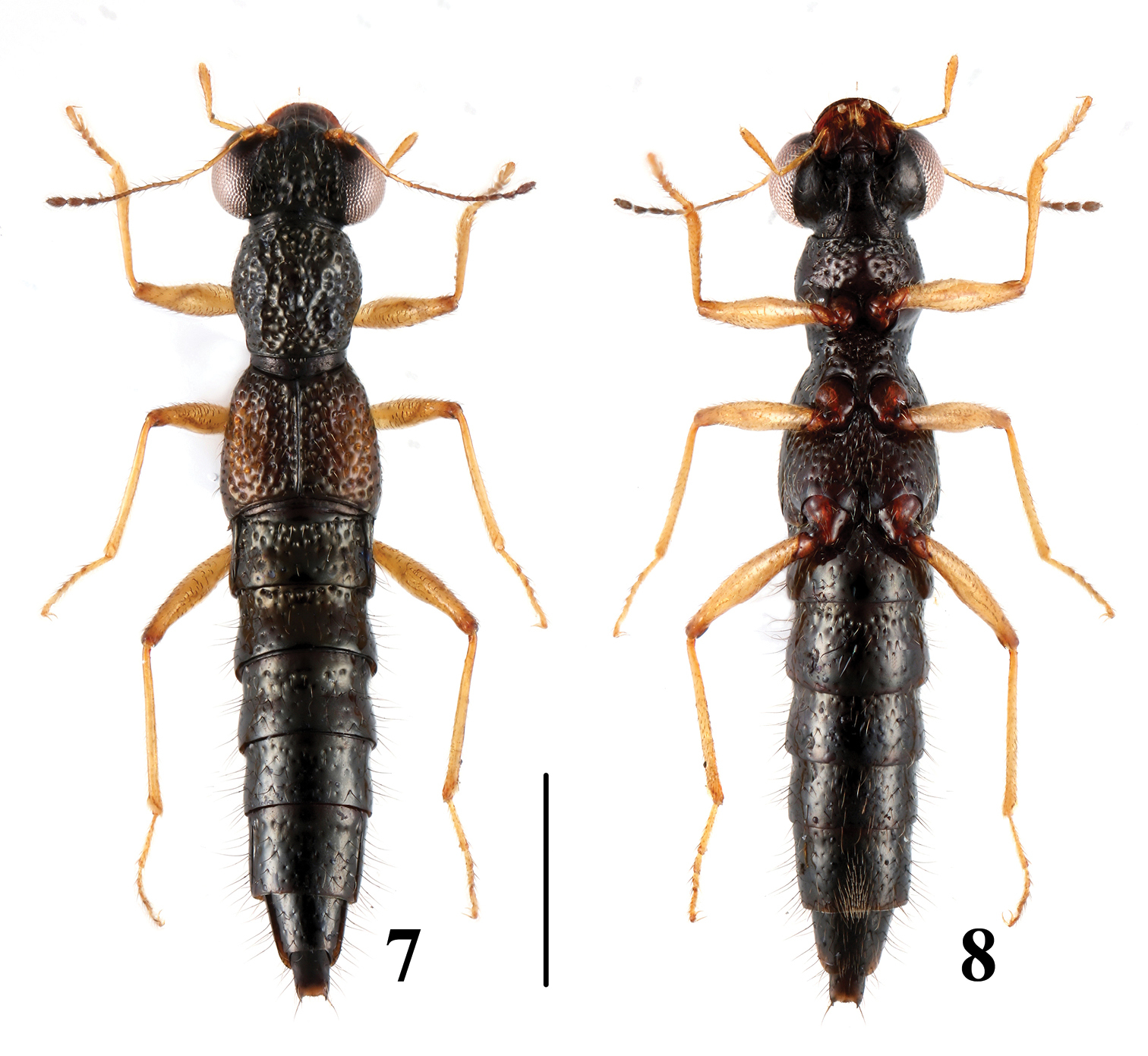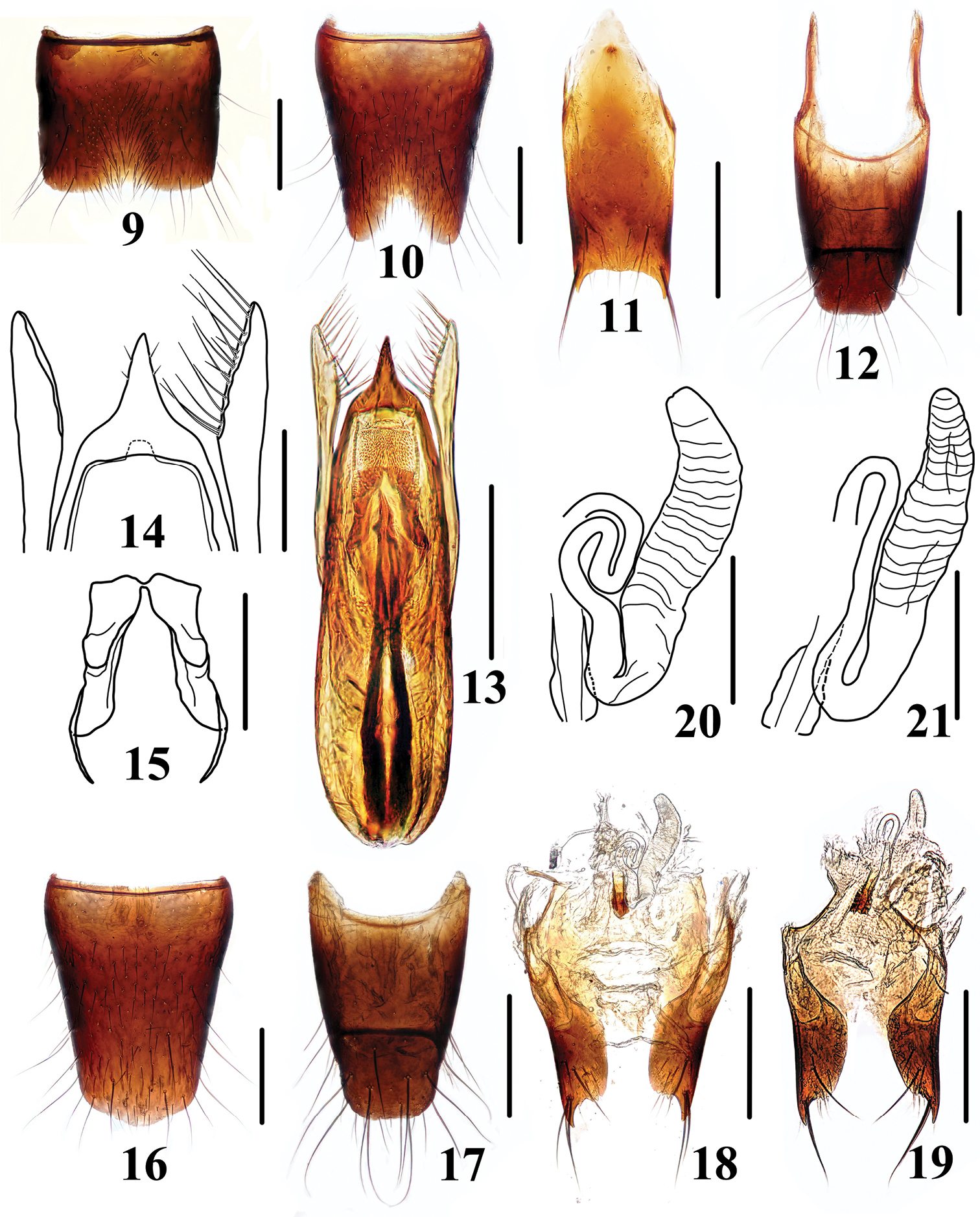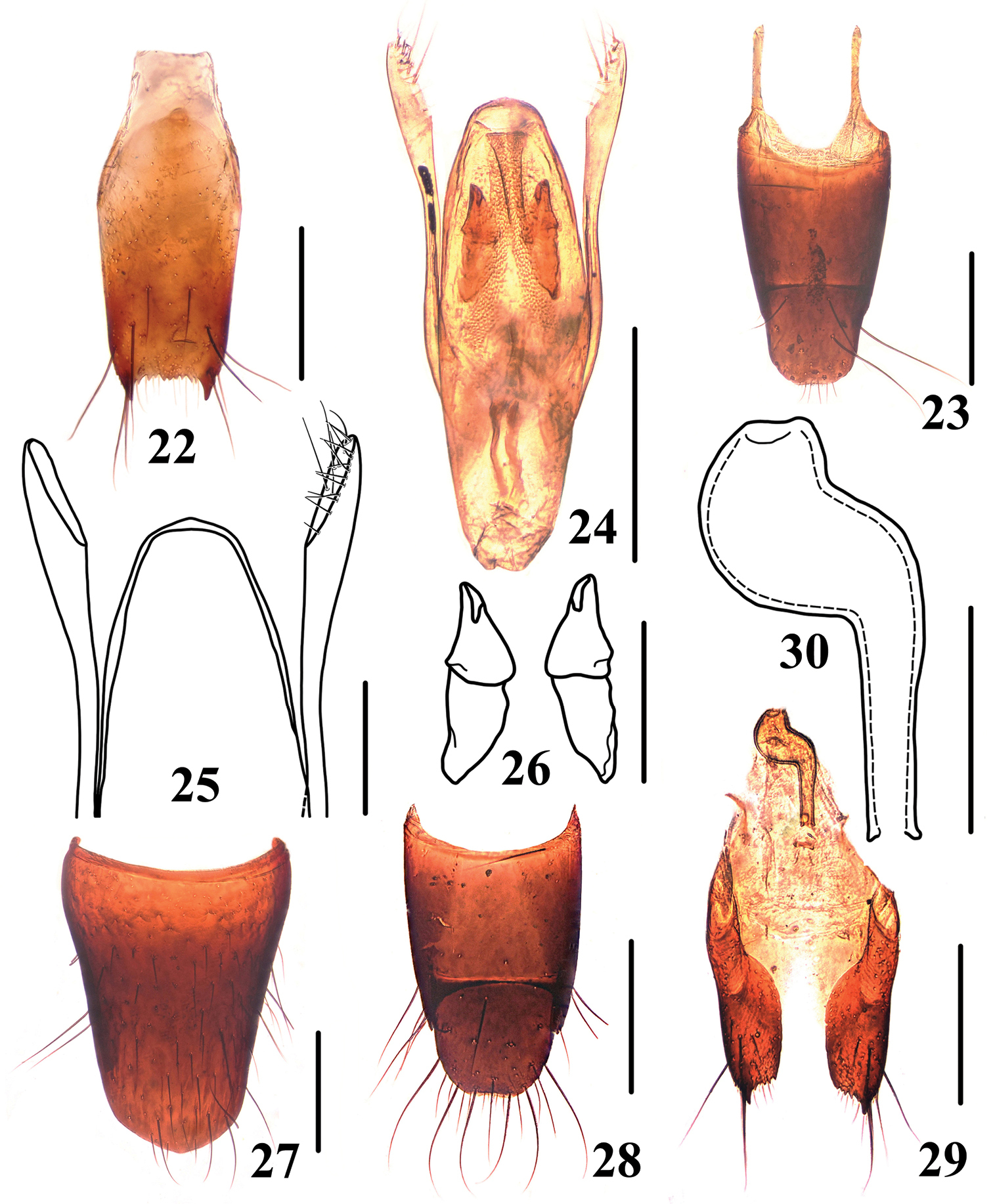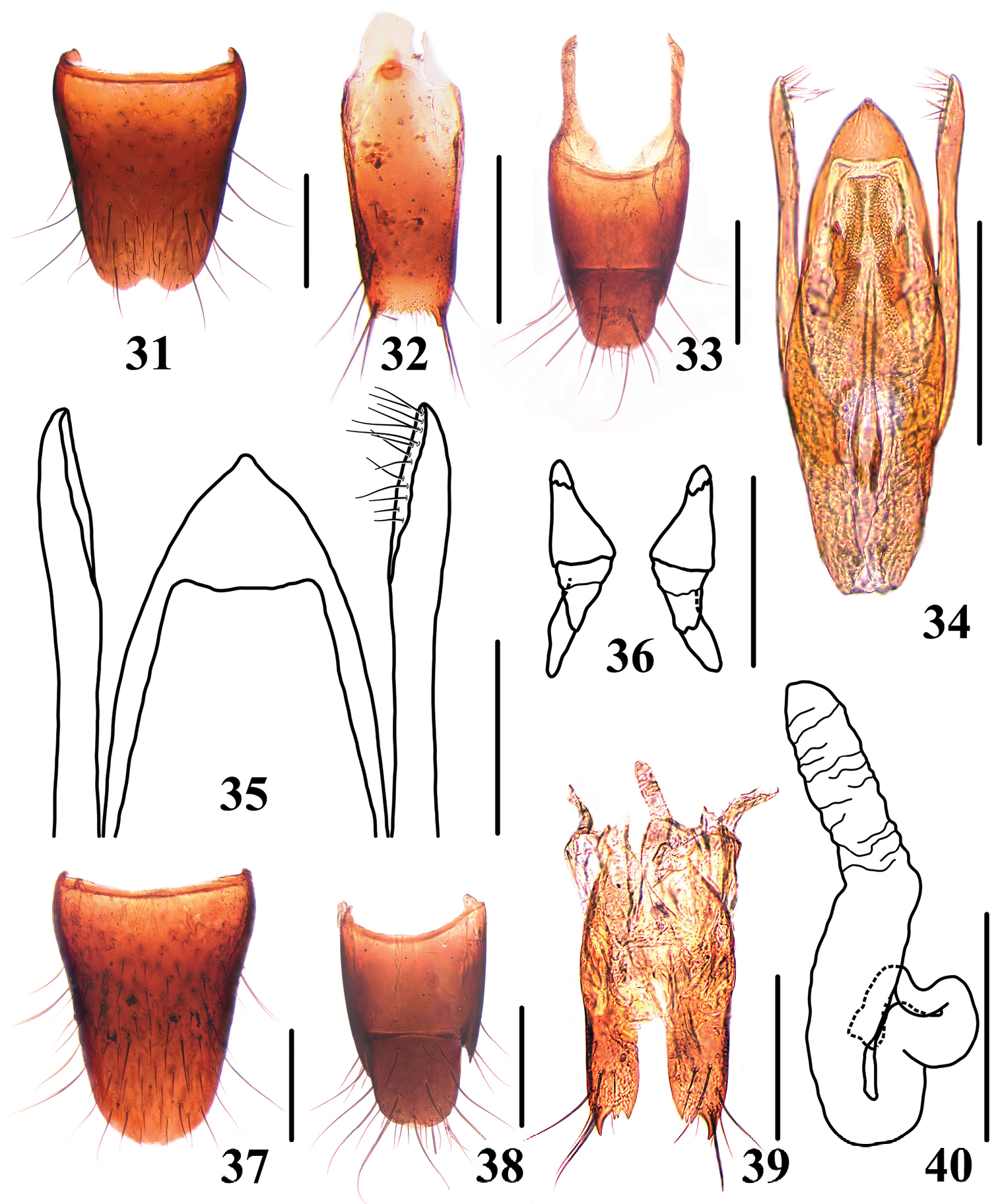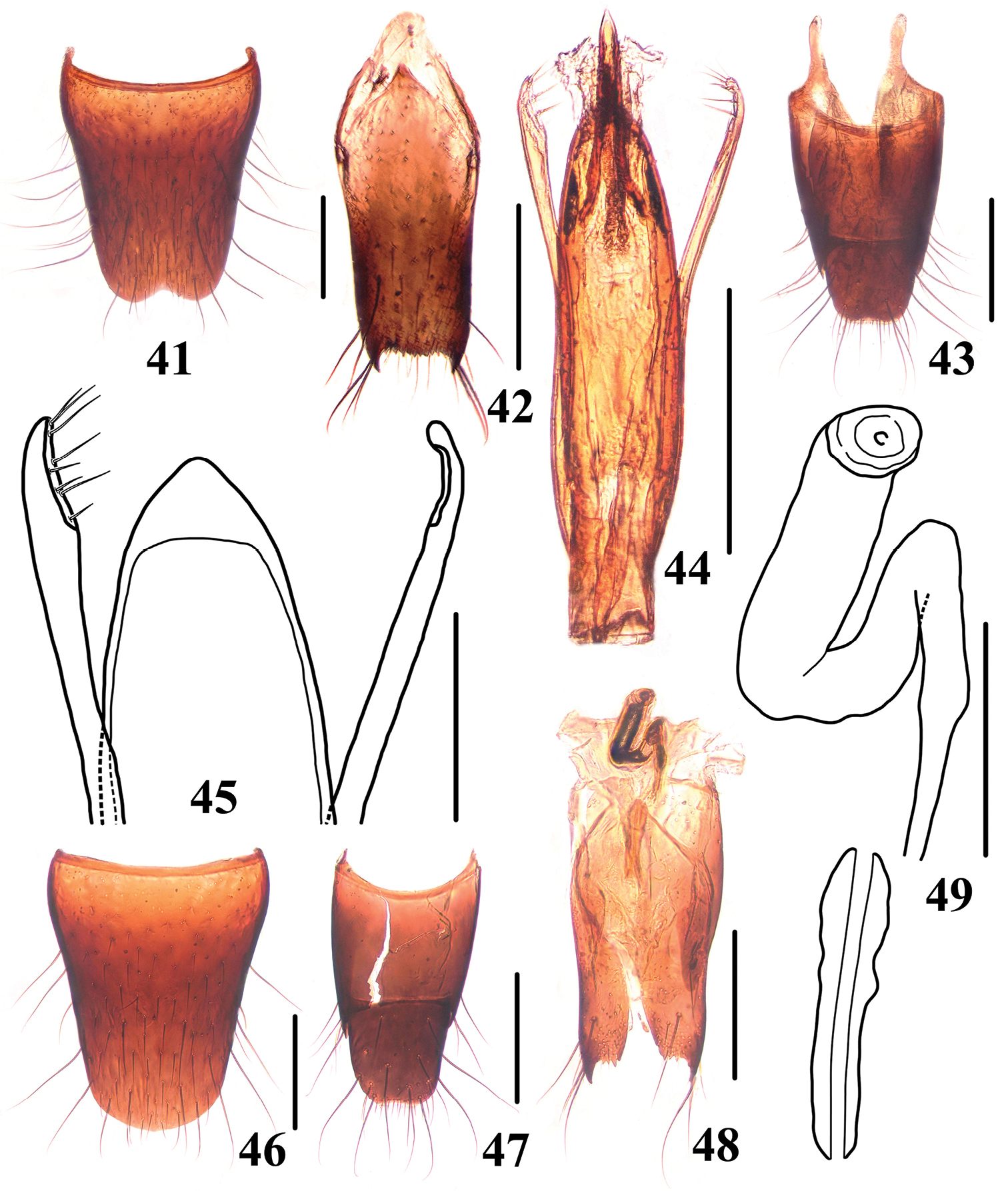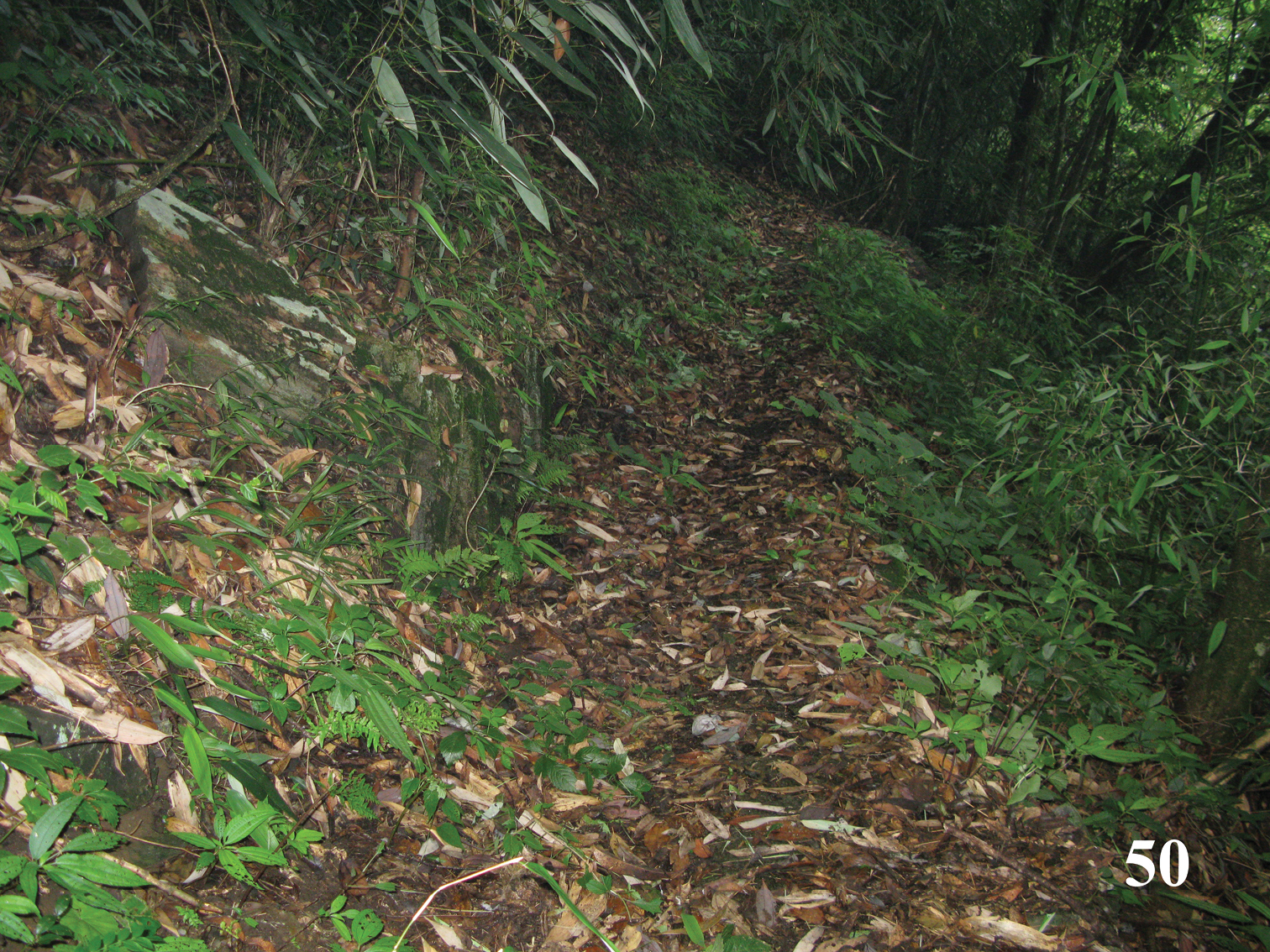






(C) 2012 Yu-Hong Pan. This is an open access article distributed under the terms of the Creative Commons Attribution License 3.0 (CC-BY), which permits unrestricted use, distribution, and reproduction in any medium, provided the original author and source are credited.
For reference, use of the paginated PDF or printed version of this article is recommended.
Two new species, Stenus zhangdinghengi sp. n., Stenus maoershanus sp. n., of the Stenus cirrus group are described from South China, Guangxi Province. The male of Stenus fellowesi Puthz, 2003 and the female of Stenus huanghaoi Tang & Li, 2008 were discovered for the first time. Their diagnostic characters are illustrated and a key to the Chinese species of the Stenus cirrus group is provided.
Coleoptera, Staphylinidae, Stenus cirrus group , identification key, new species, China
The Stenus cirrus group is a large group of the genus with 57 species worldwide and 24 species in China. The members of the group are characterized by the presence of long and erect setae on the abdomen. A detailed group definition was given by
Among the specimens we collected from China recently, the male of Stenus fellowesi Puthz, 2003, described from Hainan Province, and the female of Stenus huanghaoi Tang & Li, 2008, described from Guangdong Province, were discovered for the first time. Two species of the Stenus cirrus group collected from Guangxi Province are recognized as new and described for the first time.
Material and methodsThe specimens examined in this paper were collected by sifting leaf litter in forests. For an examination of the male genitalia, the last three abdominal segments were detached from the body after softening in hot water. The aedeagi, together with other dissected parts, were mounted in Euparal (Chroma Gesellschaft Schmidt, Koengen, Germany) on plastic slides. Photos of sexual characters were taken with a Canon G9 camera attached to an Olympus SZX 16 stereoscope; habitus photos were taken with a Canon macro photo lens MP-E 65 mm attached to a Canon EOS40D camera.
The type specimens treated in this study are deposited in the following public and private collections:
SHNU Department of Biology, Shanghai Normal University, P. R. China
cPut private collection V. Puthz, Schlitz, Germany
cRou private collection G. de Rougemont, London, England
The measurements of proportions are abbreviated as follows:
BL body length, measured from the anterior margin of the clypeus to the posterior margin of abdominal tergite X
FL forebody length, measured from the anterior margin of the clypeus to the apicolateral angle of elytra
HW width of head including eyes
PW width of pronotum
EW width of elytra
PL length of pronotum
EL length of elytra, measured from humeral angle
SL length of elytral suture
TaxonomyCHINA: Hainan Prov.: Holotype: ♀, Mt. Diaoluoshan, alt. 1040 m, 24.V.1999, J. R. Fellowes leg. (cRou). Other material: 42♂♂, 30♀♀, Mt. Diaoluoshan, Diaoluozhandao, alt. 930–1000 m, 20–23.IV.2010, YIN Zi-Wei, FENG Ting & YUAN Xiao-Zhuan leg. (1♂, 1♀ in cPut, remainder in SHNU).
Male. Sternite VII (Fig. 9) impressed in posteromedian portion with emargination along posterior margin of impression, impression densely setose; sternite VIII (Fig. 10) with a triangular emargination at middle of posterior margin, length of the emargination about 1/ 5 of total length along the midline; sternite IX (Fig. 11) with long and slightly acute apicolateral projections, posterior margin nearly straight; tergite X (Fig. 12) with posterior margin truncate. Median lobe of aedeagus (Fig. 13) broad near base and tapering apicad, apex of median lobe (Fig. 14) forming an acute projection with two pairs of short setae; parameres (Fig. 14) slightly longer than median lobe, swollen at apex, each with about 14 to 15 setae on apico-internal margins.
Habitus of Stenus fellowesi in dorsal and ventral view. Scale = 1 mm.
The duct of the spermatheca may be folded to different degrees (Figs 18–21).
China (Hainan Province: Diaoluoshan).
CHINA: Guangdong Prov.: Holotype: ♂, Ruyuan County, Nanling Nature Reserve, alt. 1019 m, 18.VI.2007, HUANG Hao & XU Wang leg. (SHNU). Other material: 1♂, Ruyuan County, Nanling Nature Reserve, alt. 1500–1800 m, 17.VIII.2008, QI Nan & YIN Zi-Wei leg. (SHNU); 2♀♀, Ruyuan County, Nanling Nature Reserve, alt. 1100 m, 14.VIII.2008, QI Nan & YIN Zi-Wei leg. (SHNU); 1♂, Shaoguan City, Nanling Nature Reserve, alt. 700 m, 18.VIII.2010, TANG Liang leg. (SHNU).
Female. Sternite VIII (Fig. 27) with posterior margin indistinctly prominent in the middle; tergite X (Fig. 28) with posterior margin broadly rounded and slightly emarginated at apex; valvifers (Fig. 29) each with big tooth at apex, posterior margin serrate; strongly sclerotized spermatheca very simple (Fig. 30).
Habitus ofStenus huanghaoi in dorsal and ventral view. Scale = 1 mm.
In the original description, the elytral mark of the species was described as obsolete. In fact, there is an indistinct elongate orange mark in the lateral portion of each elytron (Fig. 3).
China (Guangdong Province: Nanling).
urn:lsid:zoobank.org:act:01C1CD74-66DF-445E-BED7-3F6B00E5EEBE
http://species-id.net/wiki/Stenus_zhangdinghengi
Figs 5–6, 31–40Holotype: CHINA: Guangxi Prov.: ♂, Lingui County, Huaping Nature Reserve, Anjiangping, alt. 1400–1700 m, 14.VII.2011, PENG Zhong leg. (SHNU). Paratypes: CHINA: Guangxi Prov.: 4♂♂, 7♀♀, Lingui County, Huaping Nature Reserve, Anjiangping, alt. 1300–1700 m, 14–18.VII.2011, TANG Liang , HE Wen-Jia & PENG Zhong leg. (1♂, 1♀ in cPut, remainder in SHNU).
BL: 3.5–3.9 mm; FL: 1.6–1.8 mm.
HW: 0.72–0.79 mm, PW: 0.53–0.55 mm, PL: 0.55–0.60 mm, EW: 0.60–0.68 mm, EL: 0.59–0.66 mm, SL: 0.44–0.49 mm.
Brachypterous; body brownish except for the blackish head, anterior margin of labrum, antennae, maxillary palpi and legs yellowish brown, each elytron with an elongate ill-defined orange mark near lateral side, this mark 1/3 to 1/2 as long and about 1/3 to 2/5 as broad as the respective elytron.
Head 1.16–1.21 times as wide as elytra; interocular area with two broad longitudinal furrows, median portion convex dorsally, not reaching level of inner eye margins; punctation round and slightly confluent, uniform except for several large punctures at posterior part of median portion; diameter of large punctures about as wide as antennal segment II in cross-section, interstices between punctures smooth, mostly narrower than half the diameter of punctures, those along midline much wider, forming a broad impunctate line. Relative length of antennal segments from base to apex 12: 9: 20: 11: 10.5: 10.5: 9: 6.5: 7: 8: 10.5. Paraglossae oval.
Pronotum 1.05–1.09 times as long as wide, 0.81–0.88 times as wide as elytra; disk with shallow median longitudinal furrow about 1/2 the length of pronotum; punctures round and moderately confluent, smaller in size than largest punctures on head, interstices smooth, narrower than half the diameter of punctures.
Elytra 0.96–0.98 times as long as wide, distinctly constricted at base, lateral margins gently divergent posteriad; disk almost even; punctures round to elliptic, uniform, slightly coarser than those of pronotum, interstices smooth, narrower than half the diameter of punctures.
Legs with hind tarsi 0.72–0.78 times as long as hind tibiae, tarsomere IV strongly bilobed.
Abdomen cylindrical; paratergites very narrow and smooth, present only at abdominal segment III, tergite VII with indistinct palisade fringe; punctation of tergite III–VIII sparse and shallow, gradually becoming finer posteriad, interstices smooth, varying from narrower to much wider than diameter of punctures.
Male. Sternite VII with shallow emargination at middle of posterior margin and a depression before it; sternite VIII (Fig. 31) with semi-circular emargination at middle of posterior margin; sternite IX (Fig. 32) with long apicolateral projections, posterior margin serrate; tergite X (Fig. 33) with posterior margin convex. Aedeagus (Fig. 34) with apical sclerotized portion of median lobe pointed at apex; expulsion hooks (Fig. 36) very large; parameres longer than median lobe, slightly swollen at apex, each with about 14 short setae at apico-internal margins.
Female. Sternite VIII (Fig. 37) with posterior margin entire; tergite X (Fig. 38) with posterior margin convex. Valvifers (Fig. 39) each with large apicolateral tooth; sclerotized spermatheca as in Fig. 40.
Habitus of Stenus zhangdinghengi in dorsal and ventral view. Scale = 1 mm.
China (Guangxi Province: Huaping).
The new species resembles Stenus huanghaoi Tang & Li, 2008, with which it shares the faint elytral marks, but it may be distinguished by the heterogeneous punctation of the frons (in Stenus huanghaoi always similar in size), the shallower pronotal punctation (especially in the median furrow) and smaller body size (in Stenus huanghaoi BL: 3.9–4.5 mm).
This species is named in honor of Mr. Zhang Ding-Heng, administrator of the Huaping Nature Reserve, who provided help in various ways during our field work.
All the specimens were collected by sifting the leaves of bamboo and broad-leaved shrubs in a thick forest (Fig. 50).
urn:lsid:zoobank.org:act:7B0F14EB-F7AA-4B85-A751-B2E3A15EEC87
http://species-id.net/wiki/Stenus_maoershanus
Figs 7–8, 41–49Holotype: CHINA: Guangxi Prov.: ♂, Xing’an County, Mt. Mao’ershan, alt. 2100 m, 10.VII.2011, TANG Liang & HE Wen-Jia leg. (SHNU). Paratype: CHINA: Guangxi Prov.: 1♀, same data as holotype. (SHNU).
BL: 4.3 mm; FL: 2.0 mm.
HW: 0.81–0.82 mm, PW: 0.60–0.61 mm, PL: 0.63–0.64 mm, EW: 0.76 mm, EL:0.71–0.72 mm, SL: 0.54–0.55 mm.
Brachypterous; body brownish black, head darker, anterior margin of labrum, antennae, maxillary palpi and legs yellowish brown, each elytron with a large elongate orange mark near lateral margin, this mark 4/5 as long as and about 3/5 as broad as the respective elytron.
Head 1.07–1.08 times as wide as elytra; interocular area with two broad longitudinal furrows, median portion convex, almost reaching the level of inner eye margins; punctures round, slightly larger and sparser in median area than those near inner margins of eyes, diameter of large punctures as wide as apical cross section of antennal segment II, interstices between punctures smooth, mostly narrower than half the diameter of punctures, those along midline a little wider. Relative length of antennal segments from base to apex 15: 9: 24: 14: 12: 9.5: 9.5: 6.5: 7: 8: 10. Paraglossae oval.
Pronotum 1.04–1.05 times as long as wide, 0.80–0.81 times as wide as elytra; disk with distinct median longitudinal furrow, this furrow about half the length of pronotum; punctation round and confluent, similar to that of head, interstices smooth, much narrower than half the diameter of punctures except for those in median furrow, which may be wider.
Elytra 0.94–0.95 times as long as wide, distinctly constricted at base, lateral margins gently divergent posteriad; punctation similar to that of pronotum, but slightly coarser, interstices similar to those of pronotum.
Legs with hind tarsi 0.74–0.75 times as long as hind tibiae, tarsomere IV strongly bilobed.
Abdomen cylindrical; paratergites very narrow and smooth, present only in abdominal segment III, posterior margin of tergite VII with indistinct palisade fringe; punctation of tergite III–VIII sparse and shallow, gradually becoming finer posteriad, interstices smooth, varying from narrower to much wider than diameter of punctures.
Male. Sternite VII with inconspicuous emargination at middle of posterior margin, anterior to this emargination flattened; sternite VIII (Fig. 41) with semi-circular emargination at middle of posterior margin; sternite IX (Fig. 42) with long apicolateral projections, posterior margin serrate; tergite X (Fig. 43) with posterior margin truncate and slightly emarginated at middle. Aedeagus (Fig. 44) with apical sclerotized portion of median lobe triangular; expulsion hooks absent (probably lost in this specimen); parameres longer than median lobe, each with 8–9 setae on apico-internal margins.
Female. Sternite VIII (Fig. 46) inconspicuously prominent at middle of posterior margin; tergite X (Fig. 47) with posterior margin truncate and slightly emarginated at middle. Valvifers (Fig. 48) each with big apicolateral tooth; spermatheca strongly sclerotized (Fig. 49).
Habitus ofStenus maoershanus in dorsal and ventral view. Scale = 1 mm.
China (Guangxi Province: Mao’ershan).
The new species resembles Stenus nanlingmotis Tang & Li, 2008 from Guangdong, but may be distinguished by the broader and deeper pronotal furrow with wider interstices, which may be as wide as diameter of punctures (in Stenus nanlingmotis smaller than half the diameter of punctures); the elytral marks are broader, about 3/5 as broad as the respective elytron (in Stenus nanlingmotis about 2/5 as broad as the respective elytron).
The specific name is derived from “Mao’ershan”, the type locality of this species.
The female specimen was collected by sifting the leaves of bamboo and broad-leaved shrubs near the mountain summit, the male specimen was collected by beating grass along a drain exposed in sunshine.
Key to the Chinese species of the Stenus cirrus group
| 1 | Paraglossae coniform (flammeus-complex) | 2 |
| – | Paraglossae oval (cirrus-complex) | 3 |
| 2 | Body on average broader and larger; punctation of abdominal tergites VI and VII denser, interstices at most as wide as punctures. Habitus: Fig. 5 in |
Stenus flammeus Tang & Puthz, 2008 |
| China (Sichuan : Erlangshan) | ||
| – | Body on average narrower and slightly smaller; punctation of abdominal tergites VI and VII less dense, interstices up to twice as wide as punctures. Habitus: Fig. 6 in |
Stenus bostrychus Tang& Puthz, 2008 |
| China (Sichuan: Hailuogou) | ||
| 3 | Abdominal tergite III without paratergites | 4 |
| – | Abdominal tergite III with paratergites | 5 |
| 4 | Elytra unicolored; pronotum and elytra with smooth interstices. Habitus: Figs 1, 2; sexual characters: Figs 9–19. BL: 3.6–4.9 mm | Stenus fellowesi Puthz, 2003 |
| China (Hainan: Diaoluoshan) | ||
| – | Elytra bicolored; pronotum and elytra with more strongly sculptured interstices. Spermatheca: Fig. 14 in Puthz, 2003; male unknown. BL: 3.0–4.2 mm | Stenus hainanensis Puthz, 2003 |
| China (Hainan: Jianfengling) | ||
| 5 | Tergites and sternites of abdominal segments IV–VI separated by sutures | 6 |
| – | Tergites and sternites of abdominal segments IV–VI fused without sutures | 7 |
| 6 | Elytra strongly glossy with irregular and slightly confluent punctation, interstices smooth. Sexual characters: Figs 15, 16 in Puthz, 2003. BL: 2.6–3.4 mm | Stenus huangganmontium Puthz, 2003 |
| China (Jiangxi: Huanggangshan) | ||
| – | Elytra slightly glossy with regular and deep, less distinctly confluent punctation. Sexual characters: Figs 35–39 in |
Stenus cirrus L. Benick, 1940 |
| China (Zhejiang: Tianmushan) | ||
| 7 | Smaller species, BL ≥ 3.5 mm; elytra unicolored | 8 |
| – | Larger species, BL ≤ 3.0 mm; elytra bicolored, with elytral marks or with lateral elytral portion lighter | 10 |
| 8 | Punctation of forebody moderately dense, interstices strongly glossy, punctures defined. Aedeagus: Fig. 26 in Puthz, 2003. BL: 2.5–3.5 mm | Stenus falsus L. Benick, 1940 |
| China (Jiangsu: Chinkiang) | ||
| – | Punctation of forebody very dense, interstices weakly glossy at most, punctures less defined | 9 |
| 9 | Interstices of pronotal punctation distinctly reticulate. Habitus: Fig. 4 in |
Stenus shenshanjiai Tang& Puthz, 2008 |
| China (Zhejiang: Niutoushan) | ||
| – | Interstices of pronotal punctation indistinctly reticulate. Habitus: Fig. 2 in Tang, Li and Zhao 2005; sexual characters: Figs 8–11 in Tang, Li and Zhao 2005. BL: 2.3–3.2 mm | Stenus nigritus Tang, Li & Zhao, 2005 |
| China (Shaanxi: Qinling) | ||
| 10 | Head narrower than or slightly wider than elytra | 11 |
| – | Head distinctly wider than elytra | 13 |
| 11 | Head slightly wider than elytra; elytra wider than long. Aedeagus: Fig. 1 in Puthz, 1983; female unknown. BL: 3.0–3.5 mm | Stenus splendidulus Puthz, 1983 |
| China (Guangxi: S. Guilin) | ||
| – | Head distinctly narrower than elytra; elytra longer than wide. Two very similar species with fully developed wings | 12 |
| 12 | Aedeagus with narrow apical sclerotized portion, pointed at apex: Fig. 3 in Puthz, 1998. BL: 3.5–4.7 mm | Stenus guangxiensis Rougemont, 1984 |
| China (Guangxi, Zhejiang) | ||
| – | Aedeagus with broad apical sclerotized portion, rounded at apex: Fig. 4 in Puthz, 1998. BL: 3.3–4, 7 mm | Stenus aeneonitens Puthz, 1998 |
| China (Sichuan: Qingchengshan) | ||
| 13 | Punctation of frons sparse and heterogeneous | 14 |
| – | Punctation of frons dense and almost uniform | 15 |
| 14 | Elytral marks very distinct; punctation of elytra very dense, interstices of basal half of elytra narrow, forming sharp rugae. Male characters: Figs 11, 12 in Puthz, 2003; female unknown. BL: 3.0–4.0 mm | Stenus cactiventris Puthz, 2003 |
| China (Guangdong: Dawuling) | ||
| – | Elytral marks faint; punctation of elytra less dense, interstices of basal half of elytra relatively broad, not forming sharp rugae. Habitus: Figs 5, 6; sexual characters: Figs 31–40. BL: 3.5–3.9 mm | Stenus zhangdinghengi sp. n. |
| China (Guangxi: Huaping) | ||
| 15 | Punctation of pronotum and elytra dense, but not confluent | 16 |
| – | Punctation of pronotum and elytra very dense and confluent, that of the pronotum irregular. Species reliably identified only by their sexual characters | 19 |
| 16 | Elytral marks very indistinct; punctation of pronotum homogeneous and mostly well defined. Habitus: Fig. 2 in Tang, Zhao and Li 2008; sexual characters: Figs 8–12 in Tang, Zhao and Li 2008. BL: 3.4–4.0 mm | Stenus xuwangi Tang & Li, 2008 |
| China (Guangdong: Nanling) | ||
| – | Elytral marks distinct; punctation of pronotum heterogeneous and/or moderately confluent | 17 |
| 17 | Punctation on elytral marks very sparse, interstices partly wider than diameter of punctures. Male characters: Figs 9, 10 in Puthz, 2003; female unknown. BL: 3.2–4.2 mm | Stenus cooterianus Puthz, 2003 |
| China (Fujian: Wuyishan) | ||
| – | Punctation on elytral marks dense, interstices slightly wider than half the diameter of punctures | 18 |
| 18 | Body larger, BL 3.8–4.5 mm, FL 1.9–2.1 mm; elytral marks longer than half the elytra, extending towards humeral angles. Habitus: Fig. 3 in Tang, Li and Zhao 2005; sexual characters: Figs 12–15 in Tang, Li and Zhao 2005 | Stenus ovalis Tang, Li & Zhao, 2005 |
| China (Zhejiang: Wuyanling) | ||
| – | Body smaller, BL 3.2–4.1 mm, FL 1.6–1.7 mm; elytral marks shorter than half of elytral length, not extending towards humeral angles. Habitus: Fig. 1 in Tang, Li and Zhao 2005; sexual characters: Figs 4–7 in Tang, Li and Zhao 2005 | Stenus andoi Tang, Li & Zhao, 2005 |
| China (Hubei: Houhe) | ||
| 19 | Punctation of elytra very dense and confluent; male apical emargination of abdominal sternite VIII broad and shallow: Fig. 7 in |
20 |
| – | Punctation of elytra less dense, and less confluent; male apical emargination of abdominal sternite VIII narrower, rounded: Fig. 12 in |
21 |
| 20 | Elytral marks shorter, not extending towards humeral angles. Habitus: Fig. 1 in |
Stenus zhulilongi Tang & Puthz, 2008 |
| China (Zhejiang: Gutianshan) | ||
| – | Elytral marks longer, extending towards humeral angles. Sexual characters: Figs 19, 20 in Puthz, 2003. BL: 3.5–4.7 mm | Stenus lacrimulus L. Benick, 1942 |
| China (Fujian: Wuyishan) | ||
| 21 | Elytral marks distinct, less than half the length of elytra; punctation of pronotum less confluent. Habitus: Fig. 3 in |
Stenus jiulongshanus Tang & Puthz, 2008 |
| China (Zhejiang: Jiulongshan) | ||
| – | Elytral marks more than half the length of elytra (elytral marks of Stenus huanghaoi may be ill-defined); punctation of pronotum more confluent | 22 |
| 22 | Median longitudinal pronotal furrow deep, with interstices as wide as diameter of punctures. Habitus: Figs 7, 8; sexual characters: Figs 41–49. BL: 4.3 mm | Stenus maoershanus sp. n. |
| China (Guangxi: Mao’ershan) | ||
| – | Median longitudinal pronotal furrow shallow or indistinct, with interstices narrower than half the diameter of punctures | 23 |
| 23 | Body larger, FL 2.0–2.2mm | 24 |
| – | Body smaller, FL 1.8–1.9mm | 25 |
| 24 | Head relatively wide, HW 0.87–0.96mm, HW/EW 1.12–1.17. Habitus: Fig. 3 in Tang, Zhao and Li 2008; sexual characters: Figs 13–16 in Tang, Zhao and Li 2008. BL: 4.2–4.9 mm | Stenus nanlingmontis Tang & Li, 2008 |
| China (Guangdong: Nanling) | ||
| – | Head relatively narrow, HW 0.79–0.91mm, HW/EW 1.06–1.12. Habitus: Fig. 2 in |
Stenus lijinweni Tang & Puthz, 2008 |
| China (Jiangxi: Sanqingshan; Zhejiang: Gutianshan) | ||
| 25 | Punctation of pronotum heterogeneous, with moderately coarse to very coarse punctures; elytral marks distinct. Male characters: Figs 17, 18 in Puthz, 2003; female unknown. BL: 3.6–4.3 mm | Stenus wuyiensis Puthz, 2003 |
| China (Fujian: Wuyishan) | ||
| – | Punctation of pronotum uniform, very coarse; elytral marks indistinct. Habitus: Fig. 1 in Tang, Zhao and Li 2008; sexual characters: Figs 4–7 in Tang, Zhao and Li 2008. BL: 3.9–4.5 mm | Stenus huanghaoi Tang & Li, 2008 |
| China (Guangdong: Nanling) |
Stenus fellowesi 9 male sternite VII 10 male sternite VIII 11 male sternite IX 12 male tergite IX, X 13 aedeagus in ventral view 14 apex of aedeagus 15 expulsion hooks 16 female sternite VIII 17 female tergite IX, X 18–19 valvifers and spermatheca 20–21 spermatheca. Scales = 0.1 mm (14–15, 20–21), scales = 0.25 mm (9–13, 16–19).
Stenus huanghaoi 22 male sternite IX 23 male tergite IX, X 24 aedeagus in ventral view 25 apex of aedeagus 26 expulsion hooks 27 female sternite VIII 28 female tergite IX, X 29 valvifers and spermatheca 30 spermatheca. Scales = 0.1 mm (25–26, 30), scales = 0.25 mm (22–24, 27–29).
Stenus zhangdinghengi 31 male sternite VIII 32 male sternite IX 33 male tergite IX, X 34 aedeagus in ventral view 35 apex of aedeagus 36 expulsion hooks 37 female sternite VIII 38 female tergite IX, X 39 valvifers and spermatheca 40 spermatheca. Scales = 0.1 mm (35–36, 40), scales = 0.25 mm (31–34, 37–39).
Stenus maoershanus 41 male sternite VIII 42 male sternite IX 43 male tergite IX, X 44 aedeagus in ventral view 45 apex of aedeagus 46 female sternite VIII 47 female tergite IX, X 48 valvifers and spermatheca 49 spermatheca. Scales = 0.1 mm (45, 49), scales = 0.25 mm (41–44, 46–48).
Habitat of Stenus zhangdinghengi in Huaping Nature Reserve.
We would like to express our sincere gratitude to Dr. V. Puthz (Germany) for his constant guidance on our study of Chinese Steninae, to Prof. Guo-Fang Jiang (Nanjing Normal University), Mr. Ding-Heng Zhang, Mrs. Chun-Yan Shi and Mr. Lei Pan (Huaping Nature Reserve) for their assistance during our field work, and to all the collectors mentioned in the paper. The research was supported by the National Natural Science Foundation of China (No. 31101659 and No. 31172134) and the National Natural Science Foundation of Shanghai (No. 10ZR1421600).
